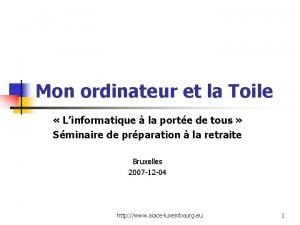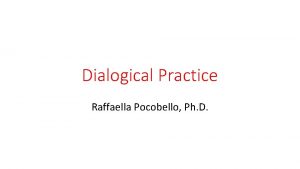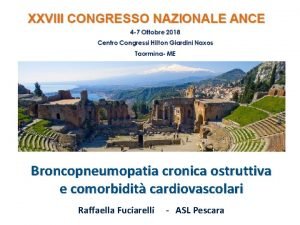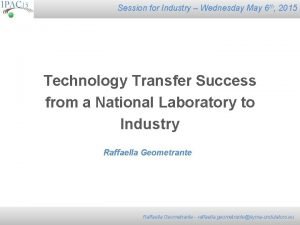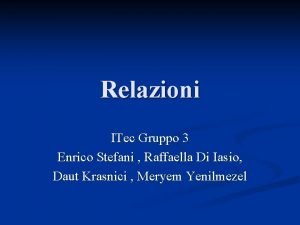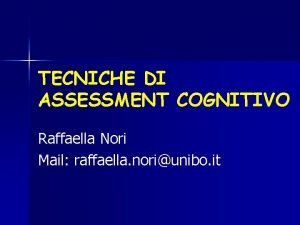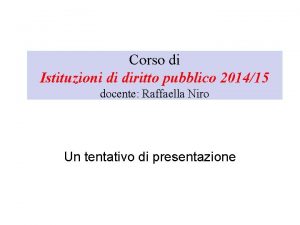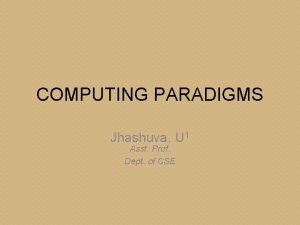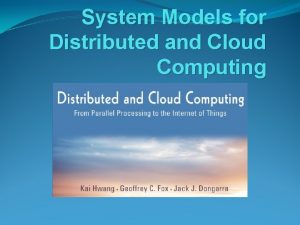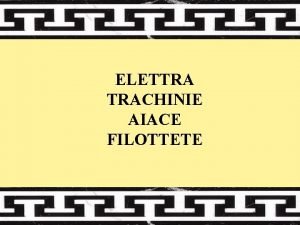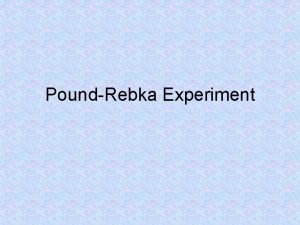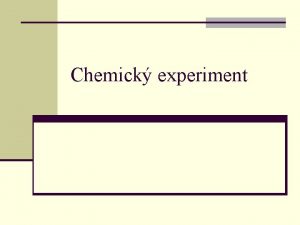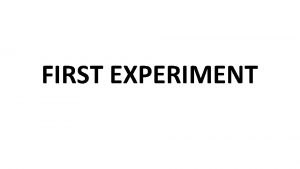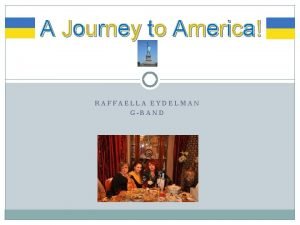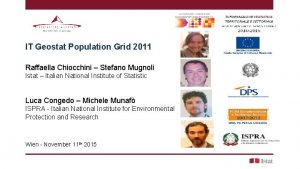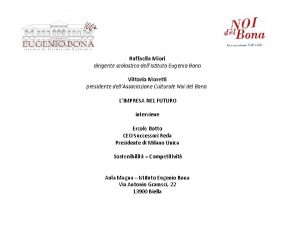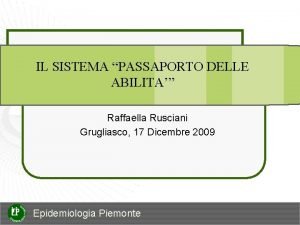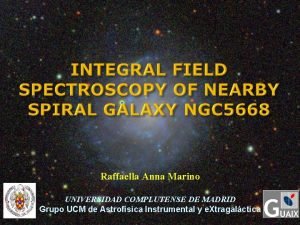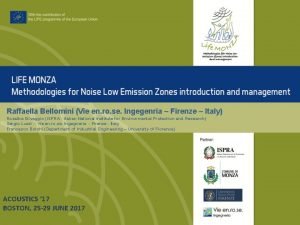Computing Resources for the AIACE Experiment Raffaella De






















- Slides: 22

Computing Resources for the AIACE Experiment Raffaella De Vita INFN – Sezione di Genova • • The AIACE experiment On-Site Computing (JLab) Off-Site Computing (Ge, LNF) Future Perspectives and Summary • Computing models/needs for other nuclear physics experiments

AIACE The Aiace Experiment Attività Italiana A CEBAF: Laboratori Nazionali di Frascati & INFN e Università di Genova Physics Goal: Study of the hadron structure and of the properties of strong interaction in terms of quarks and gluons using electromagnetic probes Experimental Setup: Jefferson Laboratory (Newport News, VA-USA) with the CEBAF accelerator (electron and photons up to 6 Ge. V) and the CLAS detector. International Collaboration (CLAS) : 35 Institutes from 7 Countries ~150 Members (~9% AIACE) Italian Collaboration: Scientist: 9. 4 fte, Technical Staff 2. 6 fte Activity: Data taking started in 1998 Publications: 55 physics papers published on refereed journals (PRL, PRC, PRD) 20 detector-related papers (NIM, IEEE) 21 papers (28%) with AIACE Leading Authors R. De Vita, INFN – Genova Computing Resources for the AIACE Experiment CCR 2007, Rimini 8 Maggio 2007

JLab and the CLAS detector electron or photon beam up to 6 Ge. V on fixed target (proton, deuteron, nuclear targets) 34 cm-2 s-1 u L = 10 u CEBAF Large Acceptance Spectrometer (CLAS) u ~ 40 000 electronic channels u Best suited for multiparticle final states u R. De Vita, INFN – Genova Computing Resources for the AIACE Experiment CCR 2007, Rimini 8 Maggio 2007

replaced/upgraded in 2004 -2006 Data Acquisition Front End Back End Readout ADCs High Resolution TDCs Drift Chamber TDCs Network ROCs UNIX cluster 8 Gb/s silo SCALERs Commercial electronics widely used VME/Fast. Bus ADCs Newly installed VME Pipeline TDCs (CAEN) Courtesy of S. Boiarinov, Jefferson Lab RAID VME Motorola controller equipped with dual CPU boards (OS: VXWorks) Fast/Gigabit Ethernet Run Control based on 3 Quad-Opteron servers (OS: Solaris / Linux) + Sun Ultra. Sparc servers 2. 5 TB Raid Array + 2000 TB Tape Silo

DAQ performane • 8 KHz event rate with maximum limit of 10 KHz set by front -end electronics dead time • 35 MB/s data rate in routine operation (50 MB/s in nonbeam test) with < 15% dead time Gbytes • Raw data volume per year ~ 300 TB CLAS 12 Courtesy of S. Boiarinov and I. Bird, Jefferson Lab R. De Vita, INFN – Genova Computing Resources for the AIACE Experiment CCR 2007, Rimini 8 Maggio 2007

Data Production data taking subdidvided into Run Periods • few weeks/months duration • different run conditions (beam/target type, beam energy, detector setup) • different physics goals Example: EG 4: Measurement of Proton Spin Structure Functions • Data taking in February-June 2006 • 20 109 triggers on tape • 70 TB raw data (35 000 files) • 5 TB estimated data volume for compressed DSTs • Statistics for MC simulation real events) (1010 0. 1 s/event 32 y on 1 CPU) R. De Vita, INFN – Genova Computing Resources for the AIACE Experiment CCR 2007, Rimini 8 Maggio 2007

On site data processing • detector calibration and raw data processing including DST production performed using on-site computing facilities, i. e. JLab farm: o 166 dual processor systems o ~360 000 specint 2000 o software: Red. Hat Enterprise Linux 3, LSF 6. 0 • 80% of computing resources available for CLAS data processing o 70 % reserved for processing of raw data o 30 % available for all CLAS users (80 cpu 150 people) • limited resources are left for physics analysis and MC simulations these tasks are performed off-site with alternative computing facilities R. De Vita, INFN – Genova Computing Resources for the AIACE Experiment CCR 2007, Rimini 8 Maggio 2007

AIACE@Genova Computing ¡ ¡ FARM Network • Fast/Gigabit Ethernet • private subnet CPU Central Linux Server § User accounts § Application software CPU Storage • 4 TB NAS • 14 TB Storage area with fiber channel technology Scientific Computing • Linux Farm 16 CPUs PBS queuing system 14 TB Storage (FCLink) SWITCH Server Applications, User accounts, . . . 4 TB NAS User Work. Station R. De Vita, INFN – Genova Computing Resources for the AIACE Experiment CCR 2007, Rimini 8 Maggio 2007

AIACE@LNF Computing PBS/PUBLIC HEAD ¡ Network • gigabit Ethernet • private subnet ¡ Storage • NAS-NAS mirror (7. 4 TB, 40% for AIACE usage) • Tape backup (30 slots) ¡ Scientific Computing • Linux Farm (30 CPUs, 60% for AIACE usage) • PBS queuing system ¡ ¡ CPU WORKER CPU public subnet private subnet Intranet Services • Directory services • Windows cluster • Windows-Linux integration Electrical and Environment • 18 KVA redundant UPS • temperature monitoring • remote management CPU volume mirror RAID 5 TAPE Courtesy of F. Ronchetti, Laboratori Nazionali di Frascati RAID 5

Off Site Data Processing • Ongoing analysis projects: LNF: 4 physics analysis of hadronic reactions 1 data set (2 TB DSTs) 4 different sets of MC simulations Genova: 5 analysis 3 data sets (15 TB DSTs) 5 different sets of MC simulations • Data transfer from JLab through network connection • Present storage resources seem adequate for local computing • Available computing power (Genova=20 CPUs + LNF=18 CPUs) not sufficient !!! Possible solution: • Usage of Tier 1 computing facilities (preferably through GRID) • Requested 50 000 specint 2000 + local storage currently not available • Other solutions: Tier 2 ? ? ? R. De Vita, INFN – Genova Computing Resources for the AIACE Experiment CCR 2007, Rimini 8 Maggio 2007

Summary • Activity of AIACE Collaboration continues at JLab with intensive data collection and analysis efforts • Data volume almost comparable with high energy experiments (LHC) • Current model based on small local storage and farms for physics analysis and simulations • Presently available computing resources not sufficient • Usage of GRID and related computing resources may solve the problem. Possibility is being considered (Not easy!!) R. De Vita, INFN – Genova Computing Resources for the AIACE Experiment CCR 2007, Rimini 8 Maggio 2007

GRID Map of the nodes of the PANDA GRID http: //panda. physics. gla. ac. uk/Alien/

PANDAGRID • PANDA Grid management is done by Glasgow group • Grid infrastructure and know-how are expanding inside PANDA • Latest additions: Pavia, Scot. Grid • Panda. Root (PANDA simulation software) installs and runs well on all platforms • The only errors encountered were due to user misconfiguration or to access restrictions (firewalls) • Panda. Root/CBM developers are now acquainted with the gridware • Panda Grid already used and always ready for simulations! http: //panda. physics. gla. ac. uk/Alien/

Latest work • Improved Panda. Root installation scripts, retested on x 86_64 • Debugged PBS and LSF problems • Established full simulation/reconstruction chain with catalogue triggers • Jobs ran in one week test: ~15000 • Necessity to link to other GRID activity http: //panda. physics. gla. ac. uk/Alien/

Fazia


Jefferson Lab Emax ~ 6 Ge. V Imax ~ 200 m. A Duty Factor ~ 100% Beam P ~ 80% Eg ~ 0. 8 - 5. 7 Ge. V CLAS R. De Vita, INFN – Genova Computing Resources for the AIACE Experiment CCR 2007, Rimini 8 Maggio 2007

Jlab Linux Farm • 1000 jobs running simultaneously • full usage of available resources • 50% of resources used CLAS for raw data reconstruction • average number of jobs/user 10 -20

Network Layout LNF Network ¡ 1+1 Gbit/s uplink Gigabit ethernet l l Private Public 1 Gbit/s uplink Cisco CAT 6000 Cisco CAT 2950 CLUSTER systems RAID 5 7 dual-CPU 4 quad-CPU Courtesy of F. Ronchetti, Laboratori Nazionali di Frascati 2 dual-CPU 1 single-CPU 1 Xeon NAS 1 P 3 NAS

30 -slot LTO 2 tape robot Storage System Computing nodes have only core OS. TAPE NFS CIFS All user and physics data reside on NAS systems RAID 5 1 Gbit/s NAS-NAS volume mirror NFS CIFS RAID 5 /users PROCOM 1750 2. 2 TB SCSI Courtesy of F. Ronchetti, Laboratori Nazionali di Frascati PROCOM 1800 5. 2 TB SCSI

Linux Scientific Computing Nodes running PBS jobs Courtesy of F. Ronchetti, Laboratori Nazionali di Frascati

Intranet Services 4 servers running Win 2 k 3: ¡ Common Windows/Linux Directory Services l ¡ Common Logical File System l l ¡ User finds same files and environment under any OS Tight integration l l ¡ DFS (Windows), NFS (Linux) have same structure (reversing slashes) Example: \ed 22dfsusers ↔ //ed 22/dfs/users Common User Areas l ¡ NIS/Active Directory (same credentials for both worlds) Windows Desktop accessible from Linux Windows and Linux HOME are the same Password changes are synchronized Printing goes through AD servers Clients/Thin Clients User access • • • Linux PCs in NIS domain use cluster file system and settings Windows PCs in AD use Windows cluster file system and settings Thin Clients can open X or RDP (Windows) sessions directly on cluster Courtesy of F. Ronchetti, Laboratori Nazionali di Frascati
 Aiace luxembourg
Aiace luxembourg Raffaella pocobello
Raffaella pocobello Fuciarelli raffaella
Fuciarelli raffaella Raffaella geometrante
Raffaella geometrante Raffaella punzo
Raffaella punzo Raffaella assetta
Raffaella assetta Enrico stefani
Enrico stefani Raffaella nori
Raffaella nori Raffaella geometrante
Raffaella geometrante Raffaella niro
Raffaella niro Raffaella niro
Raffaella niro Conventional computing and intelligent computing
Conventional computing and intelligent computing All resources are tightly coupled in computing paradigm of
All resources are tightly coupled in computing paradigm of All resources are tightly coupled in computing paradigm of
All resources are tightly coupled in computing paradigm of Variable resources definition
Variable resources definition Transformation processes
Transformation processes Renewable resources vs nonrenewable resources
Renewable resources vs nonrenewable resources Tack för att ni har lyssnat
Tack för att ni har lyssnat Rutin för avvikelsehantering
Rutin för avvikelsehantering Meios steg för steg
Meios steg för steg Lågenergihus nyproduktion
Lågenergihus nyproduktion Rbk-mätning
Rbk-mätning Myndigheten för delaktighet
Myndigheten för delaktighet
